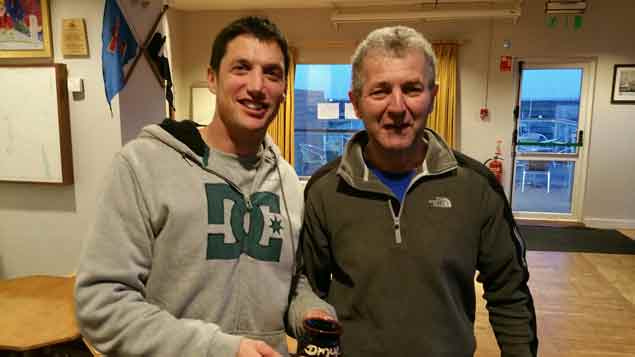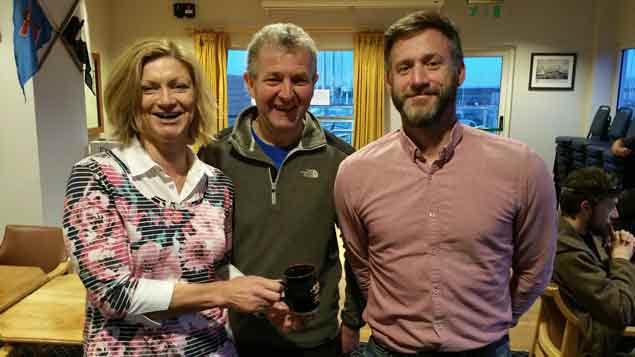The 47th running of Dun Laoghaire Motor Yacht Club’s Frostbite Series got underway yesterday in blue sky, sunny conditions and a brisk N-Westerly that reduced in strength as the afternoon wore on writes our special correspondent. Stalwart of the event, Olivier Prouveur, who announced at the conclusion of the 2016/17 Series that he would be taking a less prominent role in the managing of the event was in attendance, but in an observer role!
The Race Officer duty was undertaken by Frostbite RO debutant Cormac Bradley of the Fireball Class and for his first foray into the Frostbite Race Management the first decision was to decide if racing would take place. An early departure from DMYC with a suggestion that a postponement would be advised, if necessary, was vindicated when the assessment was that racing could proceed.
In a departure from previous formats, three starts were provided – Slow PY, (PY1), Lasers and Fast PY (PY2). And in a significant development, two windsurfers of the KONA Class joined in the racing.
Given the conditions and the “first day back” nature of the day, a single race was proposed and sailed with 5 laps of a trapezoid course used to wash away the cobwebs. Given that the keelboats, sailing their Turkey Shoot Series earlier in the morning, did not seem to be excessively hard pressed and taking into account the physical condition of the waters inside the harbour, the postponement wasn’t required and racing got underway on schedule, at 14:00.
 Solo sailor Shane McCarthy (left), the Slow PY Class winner with DMYC's Neil Colin Photo: Frank Miller
Solo sailor Shane McCarthy (left), the Slow PY Class winner with DMYC's Neil Colin Photo: Frank Miller
As an experiment the two windsurfers were put in PY1, the argument being that if they were as fast as we thought they might be they would get away from the rest of the fleet and have less traffic to deal with on the race course. Their contemporaries on the first start were a Solo, an IDRA 14 and four Laser Vagos. One of the Konas led at the first weather mark, sitting about 60m inside the harbour mouth and closer to the end of the West Pier, but the Solo was not far behind. By the time they got to the end of the five laps, the windsurfer had a good lead on the Solo on the water, but was unable to save his time in handicap terms. In third place on the water was the IDRA of Pierre Long & John Parker. Marks 2 and 3 were in the vicinity of the approach to the marina and just east of the ferry terminal respectively and while spinnakers were a rarity on the top leg of the trapezoid, they were flown on the leg from 2 to 3. Again, only the asymmetrics had any real joy with spinnakers on the bottom leg of the course. Mark 4 was in the approximate location of the memorial on the East Pier.
The finishing order on the water was Kona, Solo, IDRA, but after handicap correction the win went to the Solo of Shane McCarthy with the windsurfer second and the IDRA third.
Ten Lasers answered the starter’s call, with three Radials in the bunch. And it was one of the Radials, helmed by Clare Gorman who set the pace for the first half of the course. Eventually she was reeled in by Gary O’Hare who went on to win on the water by 24 seconds, but after handicap correction, Gorman took the first Laser Frostbite Mug by a margin of 1:09. In third place was Richard Tate.
 Fireballers Marie Barry and Noel Butler (right) the fast PY Class winners with DMYC's Neil Colin Photo: Frank Miller
Fireballers Marie Barry and Noel Butler (right) the fast PY Class winners with DMYC's Neil Colin Photo: Frank Miller
Six Fast PYs populated the last start of the day, four Fireballs, a K1 and an RS400. Noel Butler with new crew, Marie Barry (15061) led the fleet from start to finish and won with a 1:24 margin. They weren’t seriously troubled at any stage of the race and even tired spinnaker on the top reach but the blustery nature of the wind coming over the wall suggested that discretion was the better part of valour. Behind them, the battle was for second and third and was populated by Frank Miller & Ed Butler (14713) and Neil Colin & Margaret Casey (14775). While the former pair had the better start and led during the early part of the race, they were undone by an incident with a Laser at one of the leeward mark roundings. The Laser went the wrong side of the mark and got his mainsheet snagged on the mark. This cause him to go into a slow painful capsize with his mast and main snagging the trapeze wire of crew Ed Butler who subsequently went swimming. However, Miller & Butler recovered to take second place back from Colin & Casey. They cut it very fine though, only six seconds separating the two boats. The Fireballs, Butler & Barry, Miller & Butler, Colin & Casey and son and father combination, David & Michael Keegan (14676), were the first four boats home and on handicap. Tom Murphy (K1) only just beat the RS400, helmed by Stuart Harris, on the water, but beat them more comfortably on corrected time.
During the hour’s racing the wind eased as forecast and the blue sky conditions made for a good day out. Frostbites 2017/18 is up and running.
DMYC’s Frostbites 2017/18 – Day 1.
PY1 – Slow Handicap
1 Solo Shane McCarthy Coal Harbour 5302
2 Kona TBA 1969
3 IDRA Pierre Long & John Parker DMYC 161
4 Kona Des Gibney 2677
Lasers
1 Radial Claire Gorman NYC 207800
2 Full Gary O’Hare RStGYC 201364
3 Full Richard Tate 186300
4 Full Gavan Murphy 173062
PY2 – Fast Handicap
1 Fireball Noel Butler & Marie Barry NYC 15061
2 Fireball Frank Miller & Ed Butler DMYC 14713
3 Fireball Neil Colin & Margaret casey DMYC 14775
4 Fireball David & Michael Keegan RStGYC 14676
5 K1 Tom Murphy NYC 59
For a first day of the series, the entries were down on previous years, this was assumed to be a combination of the forecast, the preceding week’s mid-term break for schools and the usual need to get momentum developed. The organisers would welcome more entries in the forthcoming Sundays.

























